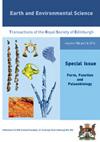综合统计和水文地球化学方法识别雷米拉平原地下水(阿尔及利亚肯切拉)盐污染的来源和过程
IF 0.9
4区 地球科学
Q4 GEOSCIENCES, MULTIDISCIPLINARY
Earth and Environmental Science Transactions of the Royal Society of Edinburgh
Pub Date : 2021-06-01
DOI:10.1017/S1755691021000207
引用次数: 0
摘要
地下水在半干旱区雷米拉平原(阿尔及利亚Khenchela)被广泛用于城市和农业供应。对70个水样进行了综合统计和水文地球化学方法,以确定水盐渍化的主要过程和起源。研究结果表明,东北海域主要为硫酸氯钙(SO4-Cl-Ca)相,大部分海域为硫酸氯钙镁(SO-4Cl-Ca-Mg)相,东南海域主要为碱土碳酸氢盐(HCO3-Ca-Mg)相。基于主成分分析和层次聚类分析,统计方法确定了三个水群:(1)咸水(17%);总溶解固体>1000 mg l−1,以硫酸盐(SO42−)为主;(2)中度咸水(17%),以碳酸氢盐(HCO3−)为主;(3)混合相中咸水(66%)。二元图证实了三个过程的优势:蒸发溶解和/或沉淀,结合离子交换。然而,在该地区的东北部,发现了另一种过程- -广泛使用地下水有利于Sabkha水的含盐侵入。本文章由计算机程序翻译,如有差异,请以英文原文为准。
Integrated statistical and hydro-geochemical approach to identify the origin and process of saline contamination of Remila plain groundwater (Khenchela, Algeria)
ABSTRACT Groundwater is widely used in the semi-arid region of Remila plain (Khenchela, Algeria) for urban and agricultural supplies. An integrated statistical and hydro-geochemical approach was performed with 70 water samples in order to identify the main processes and the origin of water salinisation. The results have suggested the dominance of three chemical facies: Sulphato cloruro calcic (SO4–Cl–Ca) in the northeastern part, Sulphato cloruro calci magnisian (SO–4Cl–Ca–Mg) in most of the waters andalkali-earth bicarbonate (HCO3–Ca–Mg) in the southeastern part. Although based on principal component analysis and hierarchical clustering analysis, the statistical approach identified three water groups: (1) saline water (17 %; total dissolved solids >1000 mg l−1 with the dominance of Sulphate (SO42−)); (2) moderately saline water (17 %) with a dominance of bicarbonate (HCO3−); and (3) moderately saline water (66 %) with mixed facies. The binary diagrams confirmed the predominance of three processes: evaporite dissolution and/or precipitation, combined by ionic exchange. In the northeastern part of the area, however, another process was detected – the saline intrusion of Sabkha water, favoured by extensive groundwater use.
求助全文
通过发布文献求助,成功后即可免费获取论文全文。
去求助
来源期刊
CiteScore
2.00
自引率
0.00%
发文量
21
期刊介绍:
Earth and Environmental Science Transactions (formerly Transactions of the Royal Society of Edinburgh: Earth Sciences) is a general earth sciences journal publishing a comprehensive selection of substantial peer-reviewed research papers, reviews and short communications of international standard across the broad spectrum of the Earth and its surface environments. The journal prides itself on the quality of its graphics and photographic reproduction. The Editors are keen to encourage interdisciplinary papers and Transactions also publishes occasional special symposia and invited volumes of specific interest.
We are currently in the process of digitising the archive of RSE Publications, and the archive of the Transactions, dating back to 1788, will be available from the back issues link on this site.

 求助内容:
求助内容: 应助结果提醒方式:
应助结果提醒方式:


